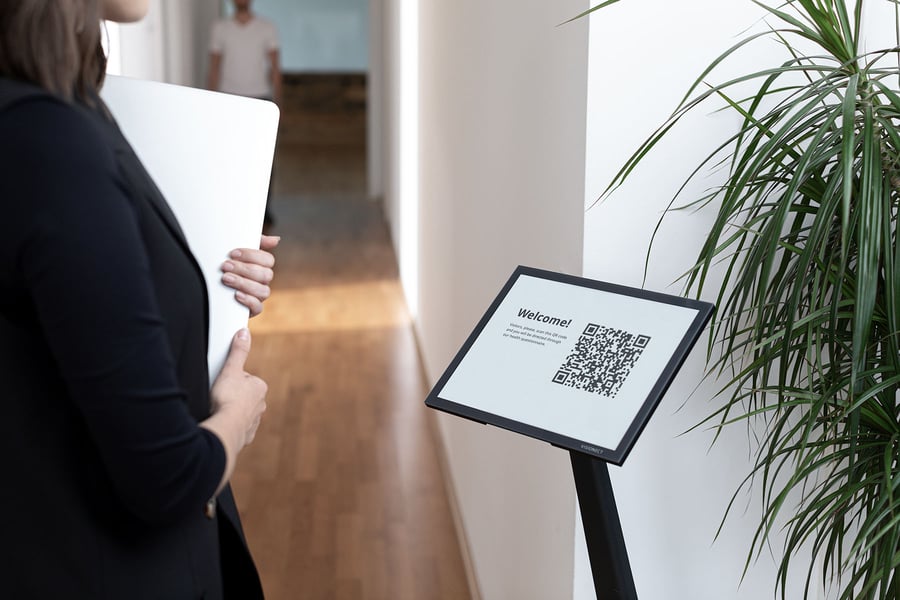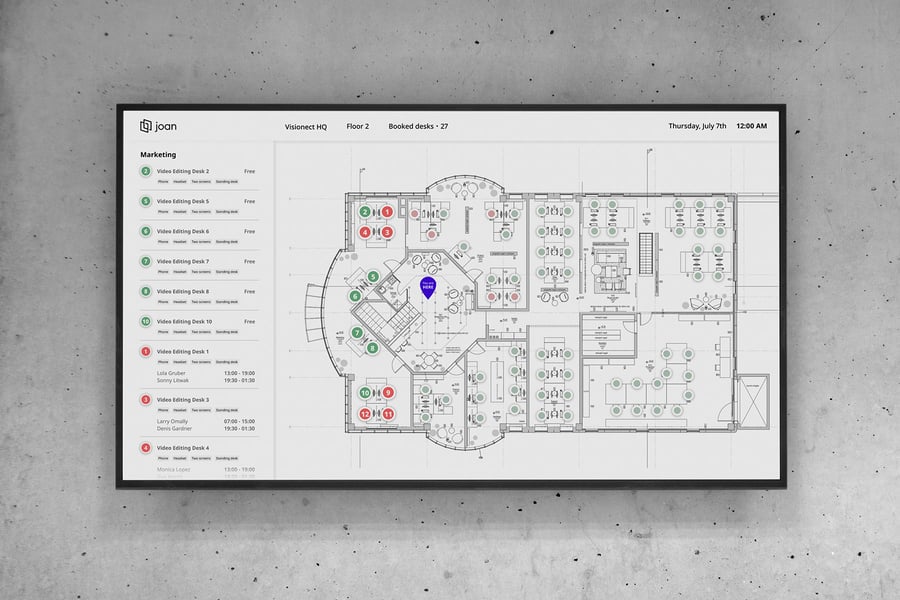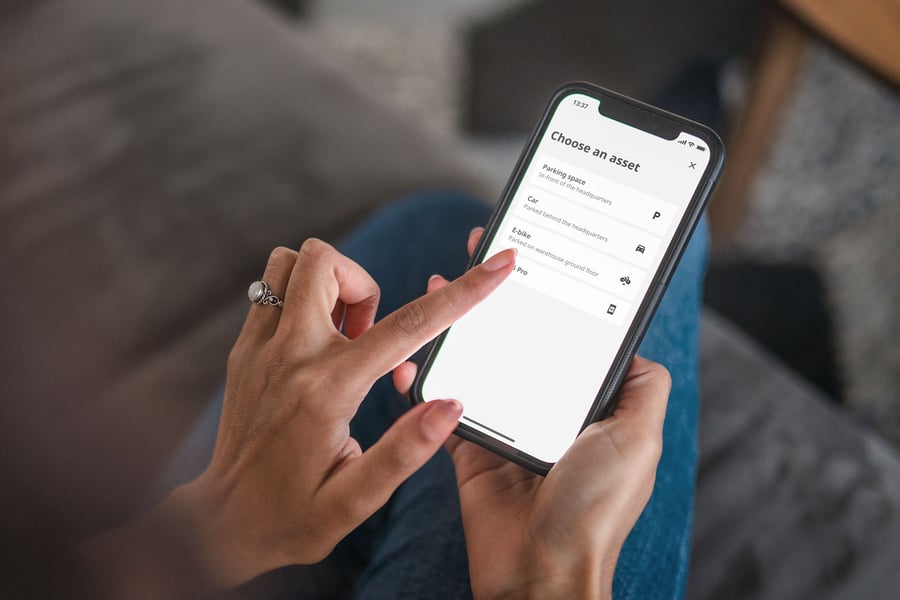Navigating an office is no easy task. Even veteran employees struggle to remember meeting room names and where to find specific departments on the floor plan. As for new employees and visitors, getting around the workplace can be downright daunting.
The office experience isn’t like entering a grocery store where aisles transition from produce to the right, frozen foods to the left, and milk at the back. With so many types of workplace models, industries, and office building structures, office designs will never be streamlined. The best-designed floor plan still leaves room for too many questions — questions that can be resolved with the right tools.
Wayfinding is becoming a huge player in improving the office experience for guests and employees alike. Let’s have a look at how wayfinding tools can transform the office experience.
The benefits of an office wayfinding system
Office wayfinding solutions are becoming more and more popular. Why? Because they offer a great ROI. Organizations have been polishing their company image plus saving time, money, and stress with the help of wayfinding. Here’s how:
- Reenforces brand equity. This concept isn’t just about branding, it’s about creating a positive response to your brand. Supporting a great office experience encourages visitors and employees to feel fondness toward your company.
- Enhances the experience. Office visitors include key players such as investors, stakeholders, and partners. In other words, people with whom your company needs to make a great impression. Clear and concise wayfinding tools help eliminate any confusion and anxiety guests and employees may feel while navigating the office space.
- Supports an organic experience. These days, society is all about self-serve options. In fact, most Millennials and Gen Z feel uncomfortable when approached. With the right signage system in place, anyone can navigate the office without asking for directions, smoothing out the office experience.
- Reduces administrative costs. Wayfinding supports a self-guided experience for new employees and visitors. Therefore, less time and fewer resources are put toward onboarding and micromanaging people within the office.
How to improve the office wayfinding experience
While wayfinding can, without a doubt, improve the work environment, there are many different forms and solutions it comes in. Posting a printout office floor map with color-coordinated seating plans won’t solve the office experience. You need to look at the whole picture — the office experience from start to finish.
Here are some areas that can be transformed with the right wayfinding design:
1. Start at the entrance
Starting at the beginning sounds logical, right? You wouldn’t guess how many companies miss this step. The wayfinding experience begins as soon as someone walks in the front door. Do visitors know what to do? Who to talk to? How to check in?
When you think of wayfinding, you probably think of floor plans, maps, and directional signs.
What you’re probably overlooking is the visitor management experience. Automating the check-in process helps eliminate data errors such as typos, misfiling, and incomplete information. So, if you’re considering automating the check-in process, why not make the experience organic? Joan offers a visitor management system that is accessible from any mobile device, allowing visitors to complete the check-in steps on their own as soon as they arrive.
2. Refine your signage game
Nothing frustrates people like unclear instructions that waste their energy and time. Get ahead of the game by providing clear signage that not only smooths out the office experience but looks sleek to boot.
Get creative with your wayfinding solutions. One overseas hotel had a banana-shaped “slippery when wet” sign guiding its visitors around a hazardous area. Believe it or not, tourists stopped to take pictures of this humorous sign, proving that creativity makes for an unforgettable experience.
Show your personality with helpful and clear wayfinding signage that supports an organic, natural experience in your workplace. The Joan 13 state-of-the-art wireless display is a favorite solution for informational signs. Not only does the digital signage look great, but it can be customized to show off company branding and slogans.

As for meeting rooms, the Joan 6 and Joan 6 Pro touchscreens offer digital wayfinding while adding sparkle to your company’s image. The e-paper meeting room displays pair with the in-house calendar in real-time to show a conference room’s availability, substantially mitigating room squatters, no-shows, and overrun meetings.
3. An absolute must for “desk hoteling”
If your flexible workplace includes desk sharing, you’re going to need a booking solution. Either that or suffer the consequences — a chaotic workspace where employees waste unnecessary time and energy trying to find an available workstation.
You might wonder, what does a booking solution have to do with wayfinding? The best booking solutions come with a mobile app complete with an interactive map of the office to help employees locate shared desks. Employees can keep track of their bookings and reserve desks before even arriving at the office, making for a great employee experience.
The Joan Desk and Asset booking solution helps employees not only reserve a desk, but book the right one too. Through the app, employees can find out where the desk is — in daylight or not, by the restrooms or not, within their department or not — and also what amenities the desk has. With the right configurations, companies can clarify which workstations have two monitors, which desks can be converted into standing desks, and more.
3.1. Desk layouts: get the big picture
When it comes to desk sharing, the more people know, the better. Desk sharing can get chaotic. With hybrid workspaces and flexible workplaces becoming more popular, the office has never been so disorganized. Companies are struggling to find the right systems to keep their offices running smoothly.
They’re missing the big picture — literally. With Joan Desk companies can present the office floor plan, complete with desk reservations and availability, in real-time on any LCD display. This way employees can discover available seating at a glance before spending time opening their Joan app or meandering the office.

4. Know where all your assets are
One office issue that’s often overlooked is the fact that most employees don’t even know what company assets are at their disposal. This issue is one of those instances where “you don’t know it’s an issue because you don’t know what you’re missing.”
More often than not, companies invest in great assets to support their employee and visitor experiences. Yet, no one knows what assets are available to them. So, what can you do? Send out a regular newsletter listing all available resources? Stick post-it notes with the words “borrow me!” on everything?
Or, invest in a booking solution that covers asset management too. The newly-minted Joan asset management system allows companies to make virtually anything bookable. You know those five parking stalls no one uses, yet your company pays a fortune for? Add them to the list of bookable resources. How about that old Nintendo 360 that’s buried somewhere in the lunchroom? Add it to the Joan booking app.
A big part of wayfinding is knowing what resources are available within a space. The Joan asset management solution can clear the picture, helping everyone get the most out of the office.

It’s all about creating the best workplace experience
First impressions always begin with wayfinding — navigating a person, place, or thing. How do you use it? How do you interact with it? Does it make sense? Was it worth it?
Luckily, Joan is pro at mastering the entire office experience. From the welcome process at the front door to those dingy back closets full of company resources, the Joan Workplace Management System has it covered.
Learn more about wayfinding with Joan by contacting our friendly sales team.
Insights that keep your office running smoothly
Fresh content on productivity, space management, and the future of work. Perfect for managers, admins, and busy teams.
Join thousands of workplace professionals who already read the Joan blog. Unsubscribe anytime.
